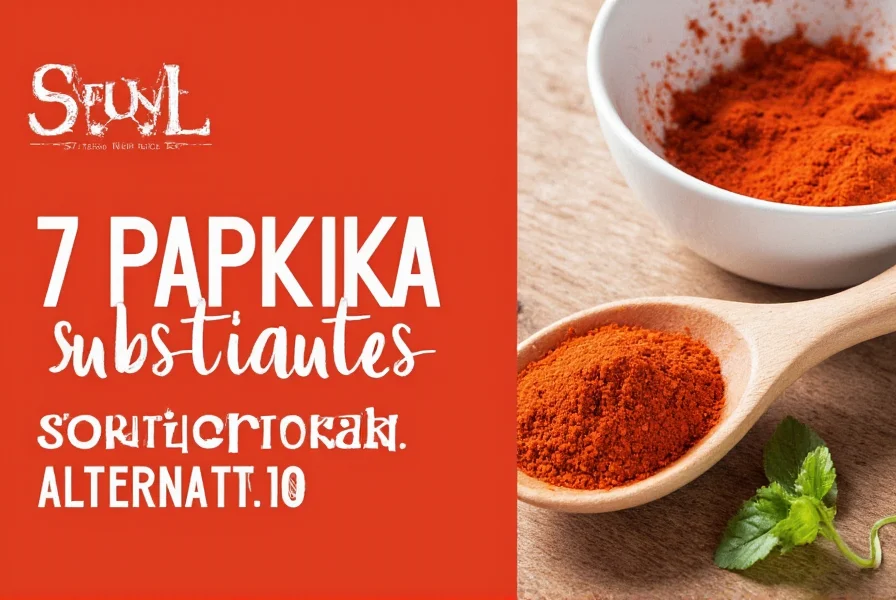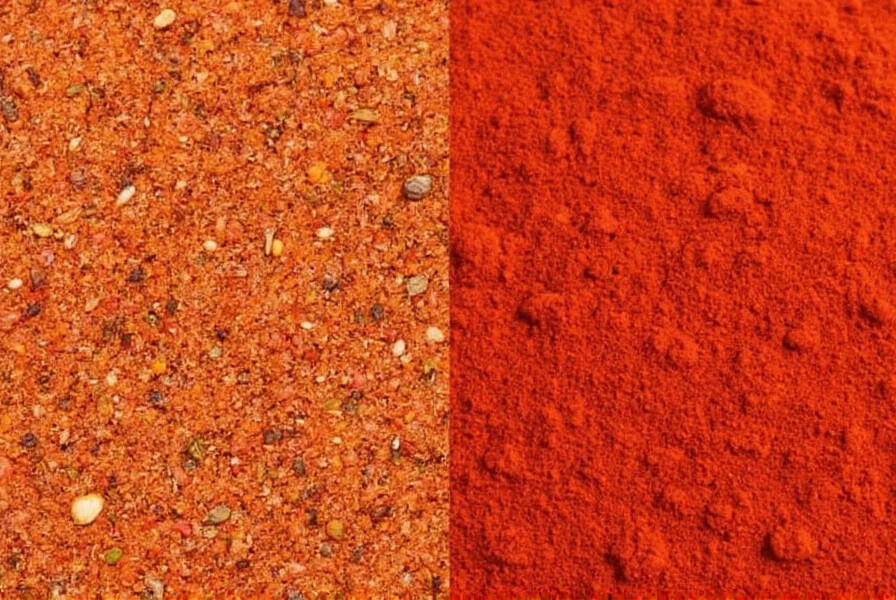If you need a paprika substitute, the best immediate alternatives are: 1) Chipotle powder (for smoked paprika, use 1:1 ratio), 2) Cayenne pepper mixed with sweet paprika (1/4 tsp cayenne + 3/4 tsp sweet paprika = 1 tsp hot paprika), 3) A blend of chili powder and garlic powder (1:1 ratio for sweet paprika), or 4) Tomato paste mixed with cumin for color and depth in stews. The right substitute depends on whether you need sweet, smoked, or hot paprika for your specific recipe.
Running out of paprika mid-recipe can derail your cooking plans, but fortunately, several common pantry staples can effectively replace this versatile spice. Whether you're making Hungarian goulash, Spanish paella, or American chili, understanding paprika's flavor profile is key to selecting the right substitute that maintains your dish's intended character.
Understanding Paprika Varieties and Their Unique Properties
Paprika isn't a single uniform spice—it comes in multiple varieties with distinct flavor profiles that serve different culinary purposes. Recognizing these differences is crucial when selecting an appropriate substitute:
- Sweet Paprika: Mild, slightly sweet flavor with vibrant red color (most common in American recipes)
- Smoked Paprika (Pimentón): Deep, woodsy flavor from smoked peppers (essential in Spanish cuisine)
- Hot Paprika: Contains capsaicin for noticeable heat while maintaining paprika's characteristic flavor
- Sweet Hungarian Paprika: More complex flavor than standard sweet paprika with subtle fruit notes
When searching for what can I use instead of paprika, consider which attribute matters most for your recipe: color, smokiness, sweetness, or heat. This determines your optimal substitution strategy.

Best Substitutes by Paprika Type
Smoked Paprika Alternatives
When you need a paprika substitute for cooking that replicates smokiness:
- Chipotle powder: Use 1:1 ratio. Provides similar smokiness with mild heat. Best for chili, barbecue rubs, and bean dishes.
- Liquid smoke + sweet paprika: 1/4 tsp liquid smoke + 3/4 tsp sweet paprika = 1 tsp smoked paprika. Use sparingly as liquid smoke can dominate.
- Smoked sea salt + sweet paprika: 1/2 tsp smoked salt + 1/2 tsp sweet paprika. Good for finishing dishes rather than cooking.
Sweet Paprika Replacements
For recipes requiring mild flavor and vibrant color without heat:
- Chili powder blend: Use 1:1 ratio. Contains cumin and garlic that alter flavor slightly but maintain color.
- Tomato paste + cumin: 1 tbsp tomato paste + 1/4 tsp cumin per teaspoon of paprika. Best for stews and braises where liquid content isn't problematic.
- Paprika-free spice blend: 1/2 tsp garlic powder + 1/4 tsp onion powder + 1/4 tsp cayenne (optional) + pinch of turmeric for color.
Hot Paprika Alternatives
When heat is essential to your recipe:
- Cayenne pepper blend: 1/4 tsp cayenne + 3/4 tsp sweet paprika (or substitute) = 1 tsp hot paprika. Adjust cayenne to taste.
- Crushed red pepper flakes: 1/2 tsp flakes + 1/2 tsp sweet paprika substitute. Provides texture along with heat.
- Hot sauce + color enhancer: 1 tsp hot sauce + pinch of tomato paste or turmeric for color. Best for liquid-based recipes.
| Substitute | Best For | Ratio | Flavor Impact |
|---|---|---|---|
| Chipotle powder | Smoked paprika replacement | 1:1 | Smoky with mild heat |
| Chili powder blend | Sweet paprika replacement | 1:1 | Earthy with garlic notes |
| Cayenne + sweet paprika | Hot paprika replacement | 1:3 | Heat with paprika base |
| Tomato paste + cumin | Color replacement | 1 tbsp + 1/4 tsp | Umami depth |
| Curry powder | General replacement | 3/4:1 | Complex spice blend |
Recipe-Specific Substitution Strategies
Understanding how to replace paprika in recipes requires considering your specific dish. Different cooking applications demand tailored approaches:
For Chili and Stews
In liquid-based dishes, focus on flavor rather than color. A combination of tomato paste (for color), cumin (for earthiness), and a touch of cayenne (for heat) creates a surprisingly effective paprika substitute ratios solution. Add these early in cooking to allow flavors to meld.
For Dry Rubs and Marinades
Dry applications require powder substitutes. For barbecue rubs needing smoked paprika, chipotle powder works perfectly at a 1:1 ratio. If making fajita seasoning without paprika, increase chili powder and add a pinch of smoked salt for complexity.
For Color-Dependent Dishes
Some dishes like deviled eggs or potato salad rely on paprika primarily for visual appeal. In these cases, a pinch of turmeric mixed with a neutral spice like garlic powder provides similar color without altering flavor significantly. Remember that turmeric has a distinct flavor, so use sparingly (1/8 tsp maximum).
What NOT to Use as Paprika Substitutes
While many spices can work as paprika alternatives for chili or other dishes, some common suggestions create problematic results:
- Plain cayenne pepper alone: Provides heat but lacks paprika's sweetness and depth, potentially overwhelming your dish
- Paprika-free chili powder: Many chili powders contain garlic and cumin that significantly alter flavor profiles
- Red pepper flakes: Adds heat but lacks paprika's characteristic flavor and creates undesirable texture
- Beet powder: Provides color but introduces earthy sweetness that doesn't complement most paprika applications
Storage Tips for Paprika and Substitutes
To maximize shelf life of both paprika and your substitute ingredients, store all spices in airtight containers away from light and heat. Properly stored, most ground spices maintain peak flavor for 6-12 months. Test older spices by rubbing a small amount between your fingers—if the aroma is weak, it's time to replace them. This ensures your homemade paprika substitute maintains optimal flavor when needed.
Creating Your Own Paprika Blend
For frequent cooks, maintaining a small collection of base spices allows you to create custom paprika blends as needed. Keep these essentials stocked:
- Sweet paprika (or chili powder as base)
- Chipotle powder
- Cayenne pepper
- Garlic powder
- Cumin
With these five ingredients, you can recreate any paprika variety by adjusting ratios. This approach provides more flexibility than seeking a single spices similar to paprika replacement and ensures you're never without a suitable option.
Can I use chili powder instead of paprika?
Yes, chili powder makes an acceptable substitute for sweet paprika at a 1:1 ratio, though it contains additional spices like cumin and garlic that will alter your dish's flavor profile. For recipes where paprika's pure pepper flavor is essential, chili powder works best in robust dishes like chili or tomato-based sauces where the additional spices complement rather than compete with other ingredients.
What's the best smoked paprika substitute without altering heat level?
The best heat-neutral smoked paprika substitute is chipotle powder used at a 1:1 ratio. While chipotle has mild heat, it's significantly less intense than cayenne-based alternatives. For completely heat-free options, combine sweet paprika with 1-2 drops of liquid smoke per teaspoon of paprika, or use smoked sea salt at a 1:2 ratio with your sweet paprika substitute.
How do I substitute paprika in Hungarian goulash?
For authentic Hungarian goulash, sweet Hungarian paprika is essential. If unavailable, create a substitute using 3/4 tsp regular sweet paprika + 1/4 tsp tomato paste + a pinch of caraway seeds. Add this early in cooking to develop flavor. Avoid hot substitutes as traditional goulash relies on paprika's sweetness rather than heat. For the characteristic red color, you can add a small amount of beet powder (1/8 tsp) if needed.
Can I make my own paprika from fresh peppers?
Yes, you can make homemade paprika by drying and grinding sweet bell peppers or mild chili peppers. Remove seeds and stems, slice peppers thinly, and dry in a low-temperature oven (150°F/65°C) for 6-12 hours until brittle. Grind to a fine powder and store in an airtight container. Note that homemade versions won't match commercial paprika's consistency but work well as a short-term substitute when needed.
Does paprika substitute work the same in baking as in savory dishes?
Paprika substitutes behave differently in baking versus savory applications. In baking (like paprika-infused breads), focus on color preservation using tomato paste or a tiny amount of beet powder. For flavor-focused baked goods, use mild substitutes like sweet paprika blended with a touch of garlic powder. Avoid hot substitutes in baking as heat elements can become more pronounced during cooking and create unpleasant bitterness.
Frequently Asked Questions
Can I use chili powder instead of paprika?
Yes, chili powder makes an acceptable substitute for sweet paprika at a 1:1 ratio, though it contains additional spices like cumin and garlic that will alter your dish's flavor profile. For recipes where paprika's pure pepper flavor is essential, chili powder works best in robust dishes like chili or tomato-based sauces where the additional spices complement rather than compete with other ingredients.
What's the best smoked paprika substitute without altering heat level?
The best heat-neutral smoked paprika substitute is chipotle powder used at a 1:1 ratio. While chipotle has mild heat, it's significantly less intense than cayenne-based alternatives. For completely heat-free options, combine sweet paprika with 1-2 drops of liquid smoke per teaspoon of paprika, or use smoked sea salt at a 1:2 ratio with your sweet paprika substitute.
How do I substitute paprika in Hungarian goulash?
For authentic Hungarian goulash, sweet Hungarian paprika is essential. If unavailable, create a substitute using 3/4 tsp regular sweet paprika + 1/4 tsp tomato paste + a pinch of caraway seeds. Add this early in cooking to develop flavor. Avoid hot substitutes as traditional goulash relies on paprika's sweetness rather than heat. For the characteristic red color, you can add a small amount of beet powder (1/8 tsp) if needed.
Can I make my own paprika from fresh peppers?
Yes, you can make homemade paprika by drying and grinding sweet bell peppers or mild chili peppers. Remove seeds and stems, slice peppers thinly, and dry in a low-temperature oven (150°F/65°C) for 6-12 hours until brittle. Grind to a fine powder and store in an airtight container. Note that homemade versions won't match commercial paprika's consistency but work well as a short-term substitute when needed.
Does paprika substitute work the same in baking as in savory dishes?
Paprika substitutes behave differently in baking versus savory applications. In baking (like paprika-infused breads), focus on color preservation using tomato paste or a tiny amount of beet powder. For flavor-focused baked goods, use mild substitutes like sweet paprika blended with a touch of garlic powder. Avoid hot substitutes in baking as heat elements can become more pronounced during cooking and create unpleasant bitterness.











 浙公网安备
33010002000092号
浙公网安备
33010002000092号 浙B2-20120091-4
浙B2-20120091-4